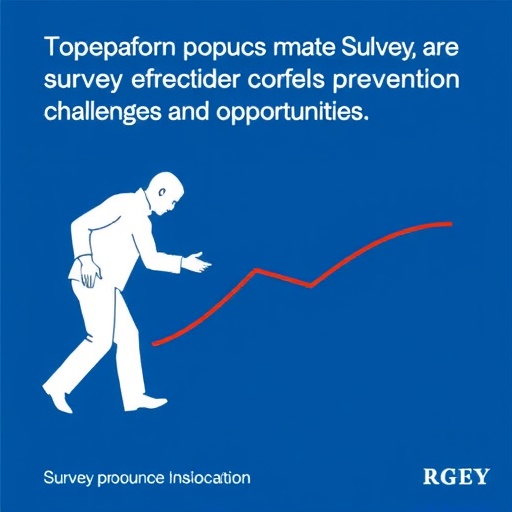
The phenomenon of falls among older adults has emerged as a pressing public health challenge globally. With an aging population in Europe, the ramifications of falls extend beyond individual injuries, impacting healthcare systems and social services. A recent study spearheaded by researchers Seppala, Frith, and Skelton delves into this pressing issue, capturing insights from healthcare professionals across Europe regarding the ongoing challenges and potential opportunities to enhance falls prevention strategies.
In this groundbreaking research published in the journal European Geriatric Medicine, diverse voices from the European healthcare landscape were brought together in an online survey, illuminating the multifaceted nature of falls and injury prevention. The study meticulously explored various aspects including the perception of risks, awareness of preventive measures, and the collective responsibility of healthcare providers and systems to offset the alarming trends in fall-related injuries. The rapidly changing demographics underscore the urgency of addressing these concerns, as older adults frequently encounter mobility issues, which in turn elevate their likelihood of experiencing falls.
Participants representing myriad professional roles, including geriatricians, nursing staff, and rehabilitation specialists, shared their experiences and observations regarding the barriers they face in implementing effective falls prevention strategies. Their insights reveal a complex web of factors, from clinical protocols that are often under-resourced to the need for comprehensive training in fall prevention measures. The survey findings indicate a widespread consensus on the necessity of continued education for healthcare professionals, as well as a call for more robust organizational support to facilitate the implementation of effective fall prevention programs.
Interestingly, the survey also highlighted several notable gaps in the existing falls prevention strategies. Many healthcare practitioners expressed concerns over insufficient interprofessional collaboration and communication, suggesting that a more integrated approach could foster better outcomes in the management of fall risks. Furthermore, the lack of standardized guidelines across different healthcare settings emerged as a significant barrier to ensuring that best practices are uniformly adhered to, leading to variability in care and potential adverse outcomes for patients.
Reflecting on the role of technology in falls prevention, respondents indicated a growing interest in digital health solutions that can assist in monitoring patients’ mobility and risk factors. Advances in wearable devices and mobile health applications have the potential to bridge the gap between clinical assessments and real-world data, thus enabling personalized interventions that align with each individual’s unique circumstances. However, the researchers behind the study caution that while technology offers promising solutions, it should be integrated thoughtfully and not serve as a standalone fix.
The study also drew attention to the societal perceptions surrounding fall risk among older adults. The stigma attached to falls—often seen as a sign of frailty or loss of independence—can deter seniors from seeking help or participating in preventive programs. Consequently, a cultural shift is necessary, one that embraces the idea that falls prevention is not just a personal concern, but a societal responsibility that necessitates awareness and advocacy at all levels.
Moreover, the qualitative data collected from the healthcare professionals illuminated the need for advocacy efforts that extend beyond clinical settings. Many respondents emphasized the importance of engaging families and communities in fall prevention initiatives. Education campaigns aimed at increasing public awareness can empower older adults and their caregivers to proactively address the risks associated with falls, thereby fostering a more supportive environment for independent living.
Another critical factor influencing the success of falls prevention programs is funding. Many healthcare leaders highlighted financial constraints as a significant barrier to adequately address fall prevention measures within their institutions. As budgets tighten across the healthcare spectrum, prioritizing funding for falls prevention initiatives must become a strategic focus for healthcare policymakers. This will be vital in ensuring that resources can be allocated toward systematic changes, training, and the introduction of innovative solutions.
The findings of the study not only underscore the urgency of addressing falls among older adults but also highlight the significant potential for interdisciplinary collaboration to forge innovative solutions. By working together, healthcare professionals from various spheres can share insights, resources, and best practices, effectively creating a cohesive approach that addresses the complexities of fall prevention.
Equipping healthcare workers with relevant training and resources is essential. The insights garnered from the survey advocate for enhanced professional development opportunities that keep healthcare practitioners updated on emerging research and techniques in fall prevention. Furthermore, institutions must also invest in soft skill training, ensuring that caregivers can communicate effectively with patients about fall risks in a manner that is both empowering and sensitive.
As the landscape of European healthcare continues to evolve, researchers conclude that embracing a proactive rather than reactive approach to falls prevention could lead to more favorable outcomes for older adults. Legislative and organizational changes that promote preventive care can not only reduce fall-related incidents but also improve the overall quality of life for seniors.
In summary, the collaborative study by Seppala and colleagues reveals a fertile ground for action that can transform falls prevention strategies across Europe. It calls upon healthcare professionals to champion efforts that tackle barriers and foster an environment of shared responsibility, benefitting not only individual patients but society at large. As this discourse continues, it is imperative that the voices of those in the field guide the collective approach to create viable solutions aimed at reducing the burden of falls among an aging population.
In closing, as Europe faces the challenges posed by its aging citizens, the time to act is now. The insights shared by healthcare professionals through this comprehensive survey provide a valuable roadmap for future interventions and highlight the transformative potential of united efforts in tackling the significant issue of falls prevention.
Subject of Research: Falls prevention strategies among older adults in European healthcare settings.
Article Title: Challenges and opportunities for falls prevention: an online survey across European healthcare professionals.
Article References:
Seppala, L.J., Frith, J., Skelton, D.A. et al. Challenges and opportunities for falls prevention: an online survey across European healthcare professionals. Eur Geriatr Med 16, 1269–1282 (2025). https://doi.org/10.1007/s41999-025-01237-5
Image Credits: AI Generated
DOI: https://doi.org/10.1007/s41999-025-01237-5
Keywords: Falls prevention, elderly care, healthcare professionals, Europe, public health, technology in healthcare, interprofessional collaboration, fall risk awareness, community involvement, funding for healthcare initiatives.
Tags: aging population and fall risksawareness of falls prevention measuresbarriers to effective fall preventionchallenges in elderly fall managementcollective responsibility in healthcareEuropean healthcare and fallsfalls prevention strategiesgeriatric care and fallshealthcare professionals insights on fallsmobility issues in older adultsopportunities for improving fall preventionpublic health implications of falls




